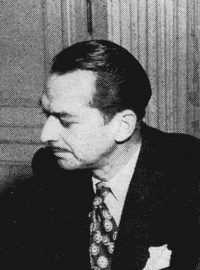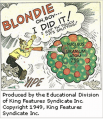Joe Musial: Difference between revisions
(→Magic Comics covers (Mandrake only): Four covers added, #20 to #23.) |
|||
| (3 intermediate revisions by the same user not shown) | |||
| Line 14: | Line 14: | ||
After graduating from the Pratt Institute in Brooklyn, New York, he studied for a year at the "Sorbonne University" in Paris, France, before becoming - in 1929 - assistant on Billy DeBeck's "Barney Google and Snuffy Smith". | After graduating from the Pratt Institute in Brooklyn, New York, he studied for a year at the "Sorbonne University" in Paris, France, before becoming - in 1929 - assistant on Billy DeBeck's "Barney Google and Snuffy Smith". | ||
After joining the staff of "King Features Syndicate" in 1932, he drew as a "ghost" artist for comic strips, such as "Blondie", "Secret Agent X9", "Bringin Up Father", "Tillie the Toiler" and often took anonymously the place of official artists when they weren't at work. | After joining the staff of "[[King Features Syndicate]]" in 1932, he drew as a "ghost" artist for comic strips, such as "Blondie", "Secret Agent X9", "Bringin Up Father", "Tillie the Toiler" and often took anonymously the place of official artists when they weren't at work. | ||
Joe Musial also drew comic strips as "Jan and Aloysius", "Teddy and Sitting Bull","Dollar A Dither" and wrote several Flash Gordon story books. | Joe Musial also drew comic strips as "Jan and Aloysius", "Teddy and Sitting Bull","Dollar A Dither" and wrote several Flash Gordon story books. | ||
Following the death of Charles H. Winner in 1956, he took over the comic strip "The Katzenjammer Kids" (the world's oldest continuing comic strip) until 1976. | Following the death of Charles H. Winner in 1956, he took over the comic strip "The Katzenjammer Kids" (the world's oldest continuing comic strip) until 1976. | ||
He was also the author of some books like "'The Career Guide for Cartoonists', " Matey visits New York" (1941), "Learn How Dagwood Splits the Atom" (1949 / see below) and "Popeye, How to Draw Cartoons", "Career Guide for Young Cartoonists" and "Comics as a Form of Communication". | He was also the author of some books like "'The Career Guide for Cartoonists', " Matey visits New York" (1941), "[[Learn How Dagwood Splits the Atom]]" (1949 / see below) and "Popeye, How to Draw Cartoons", "Career Guide for Young Cartoonists" and "Comics as a Form of Communication". | ||
In 1946, he was one of the first members of the then new founded “National Cartoonists Society (NCS)”, an organization of professional cartoonists still active in present days... and, as a representative member of this Society, he was bringing to testify - with Walt Kelly and Milton Caniff - at the hearings of the US Senate hearings which led to the establishment of the famous "Comics Code Authority" in 1954. | In 1946, he was one of the first members of the then new founded “National Cartoonists Society (NCS)”, an organization of professional cartoonists still active in present days... and, as a representative member of this Society, he was bringing to testify - with Walt Kelly and Milton Caniff - at the hearings of the US Senate hearings which led to the establishment of the famous "Comics Code Authority" in 1954. | ||
| Line 27: | Line 27: | ||
=== Magic Comics covers (Mandrake only) === | === Magic Comics covers (Mandrake only) === | ||
<gallery perrow="5"> | <gallery perrow="5"> | ||
Image:magic comics-008.jpg | Image:magic comics-008.jpg|''[[Magic Comics 8]]'' | ||
Image:magic comics-010.jpg | Image:magic comics-009.jpg|''[[Magic Comics 9]]'' | ||
Image:magic comics-011.jpg | Image:magic comics-010.jpg|''[[Magic Comics 10]]'' | ||
Image:magic comics-012.jpg | Image:magic comics-011.jpg|''[[Magic Comics 11]]'' | ||
Image:magic comics-013.jpg | Image:magic comics-012.jpg|''[[Magic Comics 12]]'' | ||
Image:magic comics-014.jpg | Image:magic comics-013.jpg|''[[Magic Comics 13]]'' | ||
Image:magic comics-015.jpg | Image:magic comics-014.jpg|''[[Magic Comics 14]]'' | ||
Image:magic comics-016.jpg | Image:magic comics-015.jpg|''[[Magic Comics 15]]'' | ||
Image:magic comics-017.jpg | Image:magic comics-016.jpg|''[[Magic Comics 16]]'' | ||
Image:magic comics-018.jpg | Image:magic comics-017.jpg|''[[Magic Comics 17]]'' | ||
Image:magic comics-019.jpg | Image:magic comics-018.jpg|''[[Magic Comics 18]]'' | ||
Image:magic comics-020.jpg | Image:magic comics-019.jpg|''[[Magic Comics 19]]'' | ||
Image:magic comics-021.jpg | Image:magic comics-020.jpg|''[[Magic Comics 20]]'' | ||
Image:magic comics-022.jpg | Image:magic comics-021.jpg|''[[Magic Comics 21]]'' | ||
Image:magic comics-023.jpg | Image:magic comics-022.jpg|''[[Magic Comics 22]]'' | ||
Image:magic comics-023.jpg|''[[Magic Comics 23]]'' | |||
Image:magic comics-024.jpg|''[[Magic Comics 24]]'' | |||
</gallery> | </gallery> | ||
=== King Comics covers (Mandrake only) === | === King Comics covers (Mandrake only) === | ||
<gallery perrow="5"> | <gallery perrow="5"> | ||
Image:kc004.jpg | Image:kc004.jpg|''[[King Comics 4]]'' | ||
</gallery> | </gallery> | ||
===== "Learn How Dagwood Splits the Atom" (Book) ===== | ===== "Learn How Dagwood Splits the Atom" (Book) ===== | ||
Following the beginnings of the Atomic era, several educational brochures or articles from magazines were destined to inform general public about nuclear power. With such a purpose, they were often written in a point-of-view strictly sponsored by nuclear industry societies. | Following the beginnings of the Atomic era, several educational brochures or articles from magazines were destined to inform general public about nuclear power. With such a purpose, they were often written in a point-of-view strictly sponsored by nuclear industry societies. | ||
In that way, the magazine "Popular Science" published in 1948 a comics-format explanation of nuclear fission entitled "Dagwood Splits the Atom" which was expanded into a complete comic-book - released by King Features Syndicate on January 1, 1949 - under the title "Learn How Dagwood Splits the Atom". | In that way, the magazine "Popular Science" published in 1948 a comics-format explanation of nuclear fission entitled "Dagwood Splits the Atom" which was expanded into a complete comic-book - released by King Features Syndicate on January 1, 1949 - under the title "Learn How Dagwood Splits the Atom". | ||
Latest revision as of 11:49, 21 October 2024
| Joseph Musial | |

| |
| Biographical information | |
| Born: | 1905 |
|---|---|
| Died: | June 6, 1977 |
| Nationality: | |
| Occupation: | Artist |
| Website: | N/A |
Joseph Musial (1905 – June 6, 1977), better known as Joe Musial, was an American comics artist and illustrator.
He was born in Yonkers, New York in 1905, from a Polish immigrant family. After graduating from the Pratt Institute in Brooklyn, New York, he studied for a year at the "Sorbonne University" in Paris, France, before becoming - in 1929 - assistant on Billy DeBeck's "Barney Google and Snuffy Smith".
After joining the staff of "King Features Syndicate" in 1932, he drew as a "ghost" artist for comic strips, such as "Blondie", "Secret Agent X9", "Bringin Up Father", "Tillie the Toiler" and often took anonymously the place of official artists when they weren't at work. Joe Musial also drew comic strips as "Jan and Aloysius", "Teddy and Sitting Bull","Dollar A Dither" and wrote several Flash Gordon story books. Following the death of Charles H. Winner in 1956, he took over the comic strip "The Katzenjammer Kids" (the world's oldest continuing comic strip) until 1976. He was also the author of some books like "'The Career Guide for Cartoonists', " Matey visits New York" (1941), "Learn How Dagwood Splits the Atom" (1949 / see below) and "Popeye, How to Draw Cartoons", "Career Guide for Young Cartoonists" and "Comics as a Form of Communication".
In 1946, he was one of the first members of the then new founded “National Cartoonists Society (NCS)”, an organization of professional cartoonists still active in present days... and, as a representative member of this Society, he was bringing to testify - with Walt Kelly and Milton Caniff - at the hearings of the US Senate hearings which led to the establishment of the famous "Comics Code Authority" in 1954.
For the "David McKay Company", he drew a great part of the covers of the "Magic Comics", "King Comics (magazine)" and "Ace Comics" issues, all "David McKay Publications". He died on the 6th June 1977 at his home in Long Island, New York.
Magic Comics covers (Mandrake only)
King Comics covers (Mandrake only)
"Learn How Dagwood Splits the Atom" (Book)
Following the beginnings of the Atomic era, several educational brochures or articles from magazines were destined to inform general public about nuclear power. With such a purpose, they were often written in a point-of-view strictly sponsored by nuclear industry societies. In that way, the magazine "Popular Science" published in 1948 a comics-format explanation of nuclear fission entitled "Dagwood Splits the Atom" which was expanded into a complete comic-book - released by King Features Syndicate on January 1, 1949 - under the title "Learn How Dagwood Splits the Atom". This book, illustrated by Joe Musial, features the Chic Young's classical character "Blondie"'s boyfriend "Dagwood Bumstead" as Atomic neophyte and "Mandrake the Magician" as Atomic professor. Two versions of the book exist, one in 12,7 x 17,7 cm and another in 17,7 x 25,4 cm with identical content and cover. It was afterwards also released with a "Harvey Comics Group" label when ordered by mail.


























